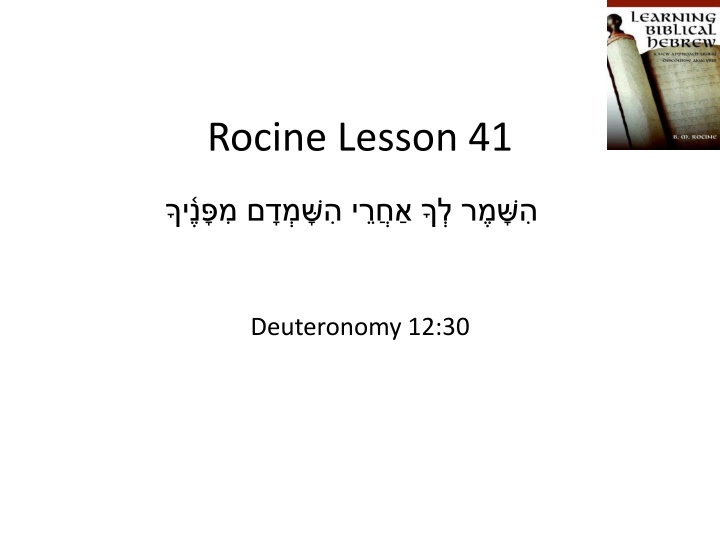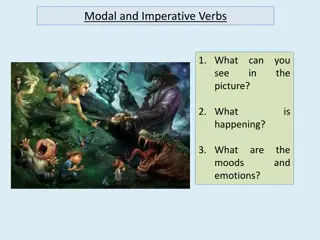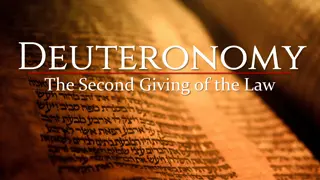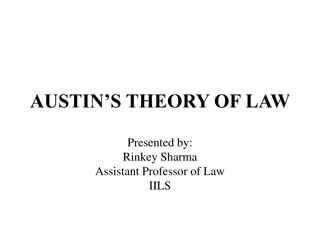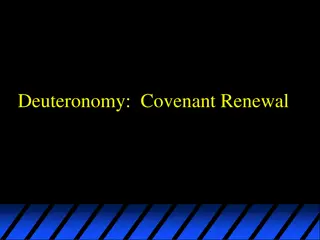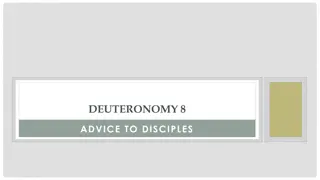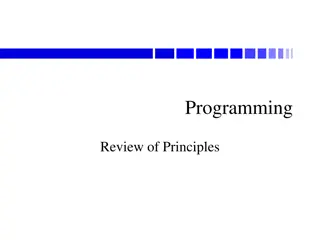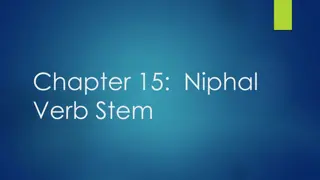Niphal Imperative in Deuteronomy: Learn and Identify
Explore the Niphal imperatives in Deuteronomy 12:30, focusing on identifying and reading the Niphal imperative and infinitive forms. Understand the rules and nuances of Niphal imperatives with detailed examples and explanations. Dive into the reflexive sense of Niphal and practice translating sentences to enhance your understanding of this form. Get ready to master Niphal imperatives with this comprehensive lesson.
Uploaded on Mar 02, 2025 | 0 Views
Download Presentation

Please find below an Image/Link to download the presentation.
The content on the website is provided AS IS for your information and personal use only. It may not be sold, licensed, or shared on other websites without obtaining consent from the author.If you encounter any issues during the download, it is possible that the publisher has removed the file from their server.
You are allowed to download the files provided on this website for personal or commercial use, subject to the condition that they are used lawfully. All files are the property of their respective owners.
The content on the website is provided AS IS for your information and personal use only. It may not be sold, licensed, or shared on other websites without obtaining consent from the author.
E N D
Presentation Transcript
Rocine Lesson 41 Deuteronomy 12:30
Goals Identify and read Niphal imperative Niphal infinitive
What we already know What kind of dagesh is in ? What Hebrew letter very commonly assimilates to the next consonant (when there is no intervening vowel) and is displayed as a dagesh?
What we already know What kind of dagesh is in ? Forte Can t be a dagesh lene because it is preceded by a vowel. What Hebrew letter very commonly assimilates to the next consonant (when there is no intervening vowel) and is displayed as a dagesh? Nun
Niphal imperative The first word in our lesson verse is a Niphal Imperative. RULE: The sign of the Niphal imperative is a pre- formed heh-hireq-dagesh forte, i.e.
Niphal imperative The first word in our lesson verse is a Niphal Imperative. RULE: The sign of the Niphal imperative is a pre- formed heh-hireq-dagesh forte, i.e. Caution: Don t confuse this with Hiphil. Hiphil imperative = Hiphil qatal = (+ no dagesh) The dagesh following the heh in the Niphal imperative is the Niphal nun that has assimilated. The Niphal imperative prefix is really but you ll never see the nun explicitly, because it always assimilates.
Niphal imperative Let s parse . Root Stem Form PGN Function Root meaning
Niphal imperative Let s parse . Root Stem Form PGN Function Root meaning Hortatory Discourse mainline To guard, be careful Niphal Imperative ms
Niphal imperative Here the Niphal has a reflexive sense. Recall Niphal can be passive, reflexive, reciprocal, etc. The also carries a reflexive sense. E.g. Given this, how might we translate the first two words of our lesson verse? Then Lamech took for himself two wives. (Gen 4:19)
Niphal imperative Here the Niphal has a reflexive sense. Recall Niphal can be passive, reflexive, reciprocal, etc. The also carries a reflexive sense. E.g. Given this, how might we translate the first two words of our lesson verse? Then Lamech took for himself two wives. (Gen 4:19) Possible suggestions: Guard yourself for yourself! (Rocine) Watch out for your own good. Be careful, for your own sake.
Niphal infinitive Infinitive Construct and Imperative look the same in the Niphal. The difference in this verse is that the infinitive has a 3mp pronominal suffix.
Niphal infinitive RULE: The sign of the Niphal infinitive is the same as the sign of the Niphal imperative, - a heh-hireq-dagesh forte, i.e.
Niphal infinitive The root in Niphal means be exterminated. How could be translated here?
Niphal infinitive The root in Niphal means be exterminated. How could be translated here? Rocine suggests using a gerund (an -ing noun): their being exterminated. See http://pr-ofenglish.blogspot.ca/2016/01/gerunds-and-infinitives.html for the difference between gerunds and infinitives in English.
Niphal infinitive In addition to context, how can Niphal infinitive and imperative be distinguished?
Niphal infinitive In addition to context, how can Niphal infinitive and imperative be distinguished? Prefixes Infinitives construct can take prefixes: e.g. A prefix is a good sign you have a infinitive construct.
Niphal infinitive In addition to context, how can Niphal infinitive and imperative be distinguished? Prefixes Infinitives construct can take prefixes: e.g. A prefix is a good sign you have a infinitive construct. Pronominal Suffixes These are more tricky. Both infinitives construct and imperatives can take pronominal suffixes. The difference is that imperatives will have a helping vowel (tsere) and the infinitives won t. See Animated Hebrew chapter 24 Pronominal Suffixes on Imperatives for details.
Niphal infinitive In addition to context, how can Niphal infinitive and imperative be distinguished? NOTE The following statement is true for niphal imperatives, but not imperatives in general. Of the two [inf. const. and imperatives], only the infinitive takes a pronominal suffix as in our lesson verse. (Rocine 41.3b, p. 233) Imperatives often take pronominal suffixes (395x in HB). E.g. Gen 1:28 Gen 22:2 Jdg 16:28 Isa 6:8 1 Kngs 18:26 Gen 19:5 subdue it and offer him there as a burnt offering remember me And I said, Here am I. Send me. O Baal, Answer us! Bring them out to us. 3fs sfx 3ms sfx 1cs sfx 1cs sfx 1cp sfx 3mp sfx (There are no 2nd person suffixes on imperatives in the Hebrew Bible, but I guess that makes sense.)
